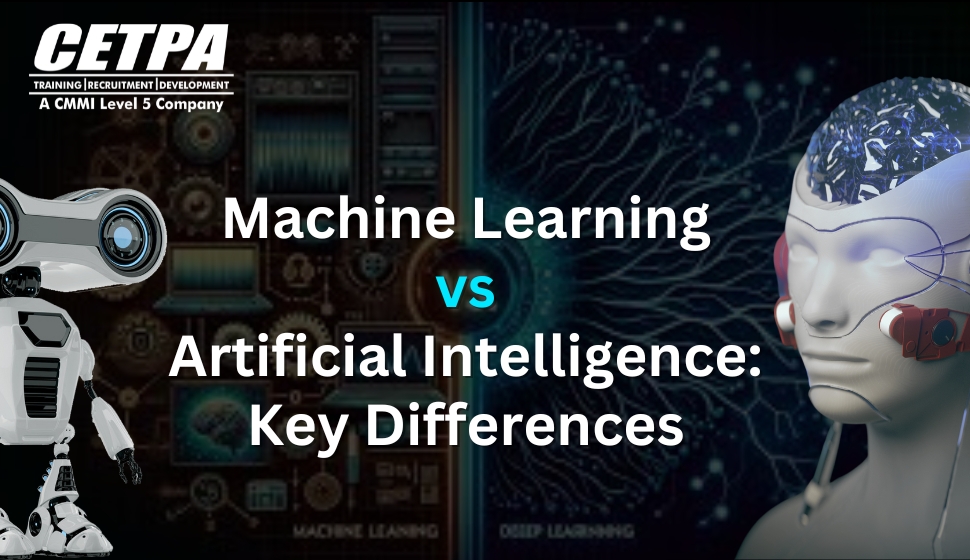In today’s tech-driven world, terms like Machine Learning (ML) and Artificial Intelligence (AI) are often used interchangeably, leading to confusion about their precise meanings and applications. Even though they are related subfields of computer science, it is important to recognize the differences between them. So why wait? Let’s figure out all of the factors and considerations to help you make a wise choice.
What is Machine Learning?
According to a popular machine learning online course, machine learning refers to a subset of artificial intelligence that concentrates on the creation of algorithms that enable computers to learn from and make decisions based on data. Instead of being explicitly programmed to perform a task, ML algorithms leverage statistical techniques to enhance their performance as more data becomes available. This capability to learn and adapt is what sets ML apart from traditional rule-based systems. The various types of machine learning include:
- Supervised Learning: The algorithm is trained using labeled data, which means that each training sample is assigned an output label. The label corrects the system’s predictions until the target accuracy is achieved.
- Unsupervised Learning: As per most machine learning course programs, this algorithm is given data without explicit instructions on what to do with it. It attempts to discover patterns and relationships within data.
- Reinforcement Learning: The algorithm learns by interacting with its surroundings and gaining rewards or punishments. It seeks to maximize the total reward.
What is Artificial Intelligence?
As introduced in top-rated artificial intelligence training programs, artificial intelligence is a broad field involving various technologies and methodologies aimed at building machines capable of performing tasks that generally require human intelligence. These tasks involve reasoning, learning, problem-solving, perception, language understanding, and interaction. AI systems are classified into two types: Narrow AI and General AI.
Narrow AI, also popularly known as Weak AI, is crafted to perform a narrow task like facial recognition, internet searches, or self-driving cars. On the contrary, General AI, popularly known as Strong AI, would have the ability to perform any intellectual task that a human can do, with the potential for consciousness and self-awareness. However, General AI remains mostly theoretical and is not attainable with present technology.

Differentiating Between Machine Learning vs. Artificial Intelligence
As introduced in a top-notch machine learning course in Noida, the key differences between machine learning and artificial intelligence are as follows:
| Factors of Differentiation | Machine Learning | Artificial Intelligence |
| Definition | Subset of AI ; algorithms learn from data | Simulates human-like intelligence |
| Learning Approach | Learns from data (training examples) | Use algorithms, rules and logic |
| Goal | Makes predictions and decisions | Mimic human cognitive functions |
| Scope | Narrower; focused on specific tasks | Broader; includes various cognitive tasks |
| Examples | Recommender systems, predictive analytics | Speech recognition, NLP, autonomous vehicles |
| Learning Type | Supervised, unsupervised, reinforcement | Rule-based, supervised, unsupervised |
| Adaptability | Learns and improves over time | Adapts to new situations and tasks |
| Applications | Finance , healthcare, marketing, etc. | Virtual assistants, robotics, autonomous vehicles, etc. |
| Complexity | Utilizes statistical techniques and algorithms | Involves advanced cognitive simulation |
| Future Potential | Enhances decision making and efficiency | Aims for human-like problem-solving ability |
Machine Learning or Artificial Intelligence: What to Choose?
According to a popular summer training program, when deciding between Machine Learning (ML) and Artificial Intelligence (AI), it’s important to recognize their relationship. As discussed in a renowned machine learning course program, choosing Machine Learning is ideal for tasks where data-driven insights and predictive analytics are paramount, such as in finance for fraud detection or in healthcare for diagnosing diseases based on patient data. On the other hand, artificial intelligence encompasses a broader scope, including machine learning along with other methodologies like rule-based systems and expert systems. Hence, opting for AI is beneficial when tackling more complex problems that require simulating human-like intelligence.
The final choice, however, is dependent on the unique aims and needs of your project. If your aim is to use data to make informed decisions or predictions within a specific domain, machine learning is likely the more appropriate choice. However, if your ambition extends to developing advanced systems that can reason, learn from experience, and adapt to new situations across various domains, then artificial intelligence, with its broader capabilities, would be the preferred path.
Conclusion:
In conclusion, while machine learning and artificial intelligence are related concepts, they differ significantly in terms of scope, learning capability, and applications. According to most machine learning course programs, machine learning is a subset of AI focused on algorithms that learn from data, whereas AI encompasses a broader spectrum of technologies aimed at simulating human intelligence. Understanding these distinctions is crucial for grasping their respective roles and potentials in shaping the future of technology and society.
Remember, both fields are crucial areas of research and development in the digital age because of their potential to transform industries, improve efficiency, and drive innovation across a wide range of domains as they continue to develop and connect. So, why wait any longer? Join the best machine learning course or artificial intelligence course today and take the next step towards career advancement!



